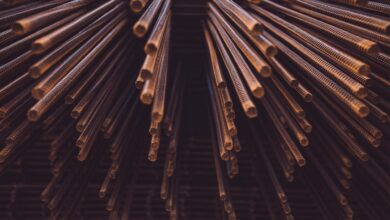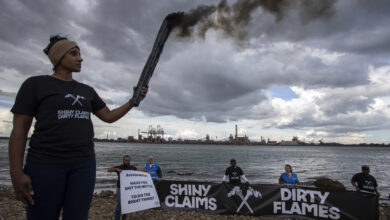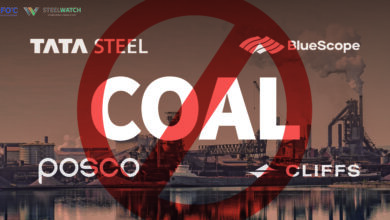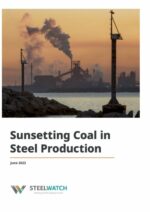ArcelorMittal’s backtracking dirties its shiny claims

ArcelorMittal claims to be at the ‘forefront of our sector in the net-zero transition’ but looking closer at reality, we see a company stalling and backsliding.
SteelWatch Director Caroline Ashley with SteelWatch Steel Analyst Romain Su
ArcelorMittal claims to be at the ‘forefront of our sector in the net-zero transition’ but looking closer at reality, we see a company stalling and backsliding.
Recently ArcelorMittal MD, Geert van Poelvoorde, made waves by revealing to the Belgian business magazine Trends that despite winning billion of subsidies from EU states for converting to low carbon steel, ArcelorMittal may not deliver the planned projects as hydrogen supplies will not be ready in Europe. This can now be read as groundwork for the very specific backtracking announcement that soon followed: in Spain, ArcelorMittal is reported to have given up on its initial project to have a green hydrogen-powered direct reduction iron (DRI) plant ready in 2025 – the “world’s first full-scale zero-carbon emissions steel plant”, in the company’s own words. Apparently it still plans to set up a DRI plant, but with fossil gas, while keeping the €450 million euro subsidy granted by the Spanish government.
This backtrack seemed shocking, after the proposed zero emissions Sestau site headline on their website so prominently for so long. But acute observers may detect a pattern of ArcelorMittal promising things one year, only to let those promises quietly dwindle in later years. And when reasons are needed, blame others.
We see a similar pattern in its announcements on blast furnaces – the bastion of coal use in steel production. Last year, SteelWatch called for an end to investments in coal-based Blast Furnace (BF): no further relining and no new construction. The climate imperative is to phase out coal-based steel production, which accounts for around 90 percent of the sector’s emissions. So we keep a keen eye on Arcelor’s huge blast furnace portfolio, and whether announced retirement plans are actually delivered.
Phasing out blast furnaces should happen first in Europe and other OECD countries, but for all its decarbonisation talk, ArcelorMittal is actually relining blast furnaces in Europe. This is tucked away from the headlines or scrutiny. Buried in its November 2023 earnings report:
- Gent steel plant, Blast Furnace A: Back in 2021, ArcelorMittal’s annual report indicated that it would be retired with substantive emissions savings of 3 MT of CO2 p.a. by 2030. Yet in the November earnings report, it is listed as being relined right now!
- Bremen steel plant, Blast Furnace 2: In 2021, it indicated its intention to replace two blast furnaces at Bremen and Eisenhüttenstadt. But Page 10 of the November earnings report refers to a ‘scheduled reline’ of Blast Furnace F2 at Bremen.
For both sites, SteelWatch enquired about the specifics, investment size, and whether ArcelorMittal will confirm the original scheduled retirement date. The company would not say.
Daniel Fairclough, the Vice President in charge of Investor Relations told SteelWatch ‘It is our policy to not comment specifically on individual blast furnaces outside of any detail noted in the earnings release.’ Well, if the company wants to tell investors first, that’s fine. However, it’s not acceptable to make declarations in public in one year, then change plans and not bother to flag them, to either investors or stakeholders. Especially given that the Gent, as well as the Bremen and Eisenhüttenstadt decarbonisation projects are supported by 280 million and 1.3 billion euros of state aid respectively. In both cases the new installations were “envisioned” to start operating in 2026.
A full blast furnace reline costs tens of millions. So it’s not something you do for just a few more years of life for an asset. We fear that ArcelorMittal has just locked these plants into another 15-20 years of coal use, with severe implications for emissions targets and destabilising our climate. Yet with no sign of embarrassment from this company that likes to polish and pronounce its green credentials.
Beyond Europe, ArcelorMittal is busy building new blast furnaces, and not only in India, in its much criticised partnership with Nippon Steel at Hazira, Gujarat. The newly released 2023 annual report confirms the continuation of ArcelorMittal’s total $800M investment in Monlevade, Brazil in what it delicately calls a “increase in liquid steel capacity by 1 million tonnes per year; sinter feed capacity of 2.25 million tonnes per year”. Translating that for you, me and the climate, it means a new blast furnace and a new coal sintering plant.
Fast forward and the outlook is no brighter. In Hamburg in January, an ArcelorMittal senior manager told us and a room full of steel sector representatives that they could not rule out running Blast Furnaces even in 2050. Of course by then they would be calling them Orwellian “smart carbon” furnaces, but there’s nothing smart about continuing to burn coal in a rapidly decarbonising world. Marginally less-polluting coal is still polluting coal. It has no place in the zero emissions economy of 2050.
True, ArcelorMittal latest annual Report contains a nod to transition away from blast furnaces: “ArcelorMittal is taking a pragmatic and considered approach to transitioning away from its existing BF-BOF assets. Clearly, older assets which are near their end of life, with lower efficiency and higher emissions, are more conducive to replacement with new, lower carbon DRI-EAF facilities.
But here comes the caveat. Transition is only where all other factors fall into the company’s lap: “Where BF-BOF assets still have a significant useful life or the policy environment is not conducive, the Company is to ensure that any new blast furnaces are using best in class technology with the potential for CCU or CCS… the economic, environmental and social policy circumstances are important factors in taking these decisions for each significant site and set of assets.” So in effect, it all depends.
Two decades and huge investment in Carbon Capture and Utilisation (CCU) in steel has produced dismal results so far. At its steel mill in Ghent (Belgium), Steelanol – ArcelorMittal’s “flagship carbon capture and utilisation project” – cost €200 million and was inaugurated with much fanfare in December 2022. Yet it “has the potential” to capture and utilise just 125,000 tonnes of CO2 per year – 1.3 percent of the steel mill’s total emissions of 9.6 million tonnes of CO2.
This is not a commitment to retire furnaces and to exit coal. It’s not an ambition to proactively create the conditions that will enable its business to get on a zero carbon pathway. This so-called leading company is planning to keep using coal and keep up the idea that a blast furnace can be a clean blast furnace, when in reality it’s a furnace that pollutes a little less, for a lot longer.
To me, this reads that business flexibility comes first, climate action and clean environments are just ‘nice to have if possible’. That other actors have the duty to mobilise a transformed market, not ArcelorMittal. It’s continuing the ‘all depends’ strategy.
It is simply not acceptable for the self-proclaimed industry ‘leader’ in decarbonisation to tout itself as a climate leader and yet deliver so little, while rowing back on its claims with barely a mention. This is what we will be arguing, as part of the Fair Steel Coalition, at a newly announced ‘Steel for People and Planet’ meeting, to be held on April 29th. The eve of the ArcelorMittal AGM in Luxembourg.
As one of the biggest players in the sector, the most globally spread company, ArcelorMittal needs to truly drive change by making a firm commitment to exit coal. And puts its weight behind the shift to green hydrogen, whether that is via green hydrogen production in Europe or importing clean sponge iron (embodied green hydrogen). This huge company is not just a passive ‘taker’ of technology and policy. It is a powerful force to shape markets and policies.
Climate policies will only get tighter as the earth gets hotter. Steel makers who do not quit coal, however big they are, will get left behind, leaving a legacy of climate chaos in their wake. Some have got the message: coal is done. Arcelor needs to take this to heart, and actually deliver on its shiny claims.




